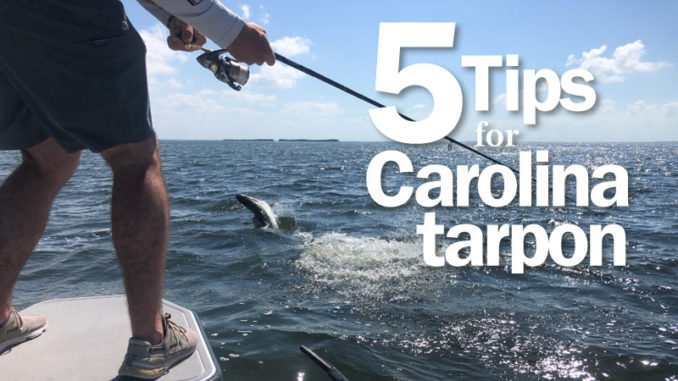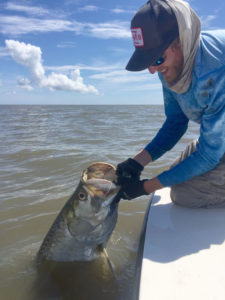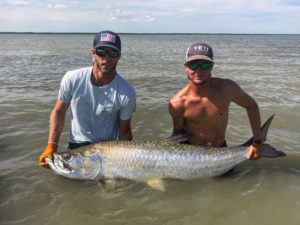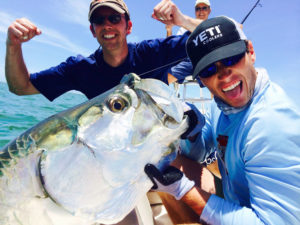
Tarpon make long migrations to the Carolinas every summer. Here are the best ways to connect with one.
Hooking a tarpon on rod and reel is the closest thing to riding a rodeo bull that most anglers will experience. These massive, strong fish are often fickle in where they feed and what they’ll eat. But once the hook is sunk in their jaws, all bets are off.
The downside to tarpon fishing in the Carolinas is that targeting these brutes is often difficult, because the numbers that enter our waters in the summer on the way north from Florida pales compared to the number of sharks, rays and redfish that feed in the same areas. Most anglers consider getting one bite from a tarpon — after wading through everything else that bites — to be a successful trip. And few guides will guarantee a tarpon — but they’re willing to give it their best shot.
Justin Carter of Redfin Charters in Charleston, S.C., is one of these guides. Through networking and comparing notes with other captains who guide for Redfin, Carter has put together a better-than-average, predictable pattern for finding and hooking tarpon.
Getting one to the boat is another matter altogether.

Location
Like the retail business, tarpon fishing is all about location. Carter said inlets and areas like sandbars, dredge piles and surf lines close to the ocean are his top choices for finding tarpon. He’s looking for areas that create choke points, forcing bait into smaller areas.
“Tarpon will sit on the edges of these areas and ambush prey as the wind, tide and waves push bait around,” he said. “Most of the time, these areas will not be clear water. So you won’t see these fish unless they are rolling in the surf or in the break lines.”
Carter said many anglers have heard stories or even had experiences during the summer, with hooking a tarpon in a deep hole or back in a creek, but that has rarely been his experience.
“Most of my best tarpon spots are within sight of the open ocean, in water that is less than 15 feet deep,” he said.
Tides
Carter cannot point to a specific tide as being better than another when it comes to tarpon fishing. The fish simply relate to these areas differently based on the stage of the tide you’re fishing. He said that the fish relate to an inlet or a sandbar or dredge pile based on where the bait is located. He said fish can bite on any point of the tide if you are positioned correctly.
“On the outgoing tides, the fish often position themselves outside an inlet,” he said. “If you have a sandbar with a chute running through it, they may run up and down that chute.”
Conversely, he said, an incoming tide will often find tarpon holding along the inside edges of an inlet, again capitalizing on current rips that bring food their way. If wind, waves or crosscurrents pile up on one side of the inlet on the rising tide, he’ll most likely pick that side.
“At dead-high or dead-low, these fish don’t leave or shut down like some other species,” he said. “Then, it all depends on the presence of bait. If bait is concentrated in the area, there’s usually tarpon there too.”

Bait for tarpon fishing
The bait category covers three facets of tarpon fishing:
- What the angler is seeing in the area;
- What the fish are feeding on;
- What’s on your hook.
Surprisingly, they aren’t always the same thing.
“Big numbers of smaller mullet or smaller numbers of big mullet is a good sign,” Carter said. “So is seeing big schools of menhaden. Tarpon definitely feed on all of those, but don’t forget, these big fish will eat other fish that are feeding on much smaller bait.”
Carter often uses a tower or poling platform and/or a pair of binoculars to look for active signs of life in an inlet or other nearshore area. Nearly every time he finds active bait, he’ll also catch glimpses of tarpon rolling.
He might see plenty of mullet or menhaden in an area. But that’s probably not what he’s going to use for bait.
“I want a bait that stands out in a crowd of baitfish. So I’m more likely to use a croaker, spot or pinfish, something that really shines and stands out to a feeding tarpon,” he said.
Baits are always fished whole, regardless of the species, to prevent a lot of the by-catch that always accompanies a tarpon fishing trip.
“So many sharks and rays use these areas. We don’t need to advertise by using cut bait,” he said. “I’m not talking about small sharks, either. We catch a lot of big sharks while tarpon fishing.”
Presentation
Carter will anchor his boat using an anchor, Power Pole or spot-lock trolling motor. Baits are all free-lined behind the boat, usually with no weight but sometimes with a ½-ounce sinker to keep the bait off the surface in heavy current.
“You don’t want a big weight near the nose of the fish when he’s hooked,” he said. “They shake their head on a jump and dislodge the hook.”

Tackle
Carter’s choice of tackle is a 7½- to 8-foot, heavy action rod with a long taper. He uses a St. Croix rod paired with a 6500 Penn Slammer or other baitrunner style reel spooled with 60-pound braid, with a 20-foot leader of 80- to 100-pound Sufix Superior mono and 5/0 to 8/0 Gamakatsu circle hooks.
Bonus: Artificial Baits
While most tarpon in the Carolinas are caught on live bait, Carter said there are times and occasions when you can sight-fish for tarpon with artificial lures.
According to Carter, most of these artificial-bait opportunities come when scouting an area for tarpon and casting ahead of the fish as they roll or breach while feeding.
“I have had occasions where I had a small school of tarpon around the boat,” he said. “Generally, our water is too murky for sight-fishing, but not always. A good, incoming tide will be clear enough that you can see them.”
Like sight-fishing for any predator fish, Carter said it’s better to cast in front of the fish and let the current sweep the bait to it. This is much easier to do in a changing tide than on a dead tide.
“A bait charging at a predator is not natural and they’ll almost always pass it up,” he said. “You want to place the lure in the water and have the fish move to the lure or the current wash it to the fish.”
Carter’s preferences for artificial baits are a Z-Man HeroZ, a 10-inch bait, or a 6-inch SwimmerZ. He will rig them on a 7/0 to 10/0 swimbait hook.
He’ll sight-cast to tarpon using an 8-foot, medium-heavy St. Croix Avid spinning rod paired with a 5500 Penn reel spooled with 50-pound braid. He shortens his leader to a 4- to 6-foot length of 50-pound mono.



